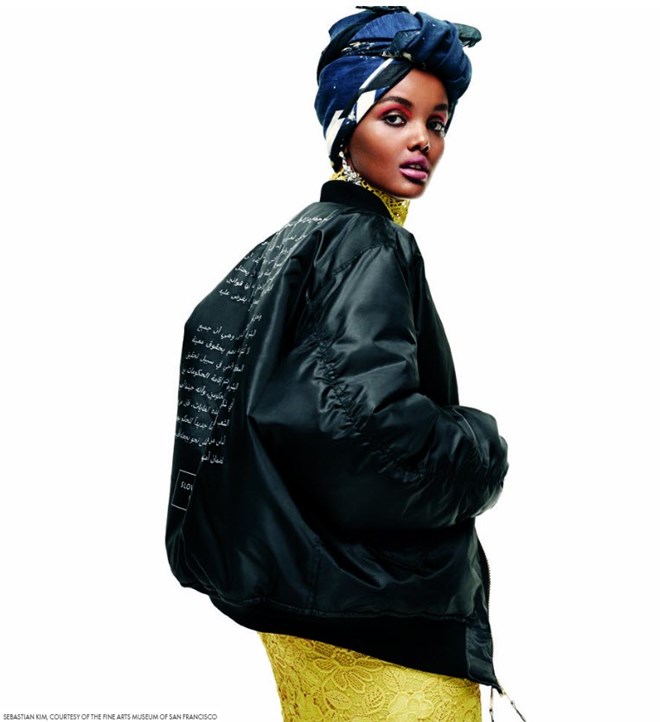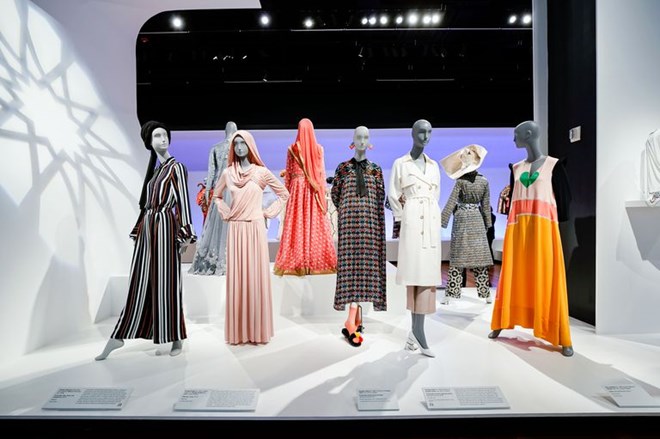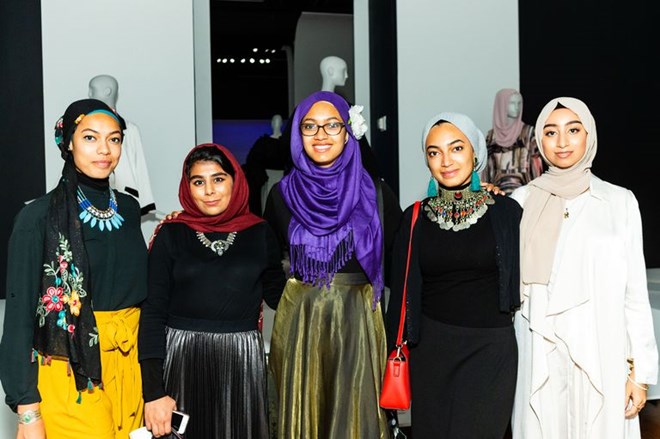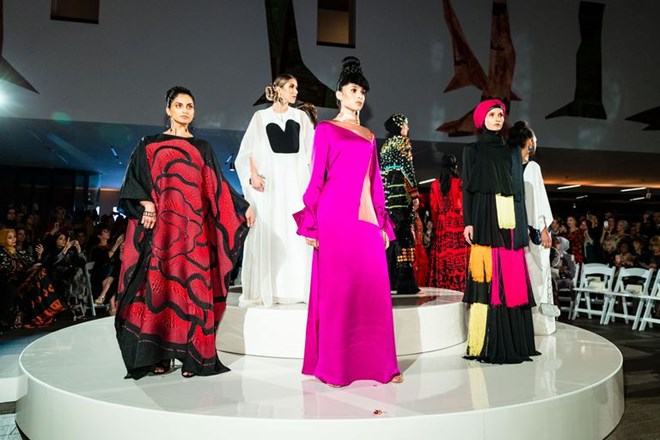Elle
Wednesday October 3, 2018
BY JENNIFER CHOWDHURY

When the the non-Muslim world thinks of clothing for observant Muslim women, they tend to picture unflattering and loose silhouettes in drab, dark colors. But style options are endless as long as modesty is a component: some women choose to cover their hair with turban styles, others with hijabs wrapped in soft layers to frame the face; and others do not cover their hair at all, choosing to focus on long dress lengths and sleeves. These choices are rarely discussed in mainstream fashion publications, but over the last few decades, Muslim women all over the world have collectively decided to take control of their sartorial image, and social media is helping them do it.

DREW ALTIZER PHOTOGRAPHY
A new exhibit at the Fine Arts Museums of San Francisco aims to showcase all of the elements that make up Muslim women’s fashion. Contemporary Muslim Fashions shows over eighty different ensembles, from burkinis to ball gowns to sportswear, created by both established and emerging designers from all over the world. Fine art photographs and social media installations line the walls of the exhibit to help illustrate the layered and complicated story of modest Muslim fashion.
“The modest fashion industry is estimated at $44 billion,” said Reina Lewis, a professor and the author of Muslim Fashion: Contemporary Style Cultures who’s the consulting curator for Contemporary Muslim Fashions. “It’s rising faster than other sectors. Muslims, globally, are a youthful and growing population and modest fashion is having a moment on the global catwalks."
Max Hollein, former Director and CEO of the Fine Arts Museums of San Francisco, enlisted Lewis to join Jill D’Alessandro, Curator in Charge of Costume and Textile Arts, and Laura L. Camerlengo, Associate Curator of Costume and Textiles at the Fine Arts Museums of San Francisco, to curate this exhibit two years ago. They worked closely with the local Muslim community to solicit feedback on the project.
MIDDLE EASTERN WOMEN, IN PARTICULAR, ARE HIGH CONSUMERS OF LUXURY FASHION. THEY ARE VERY EDUCATED AND LEAD INTERNATIONAL LIVES
.
For the title of the exhibit, the curators emphasized the term fashions in the plural because the Muslim fashion world is often seen as a monolith.
“There are very many different ways Muslim culture and ancestry interpret their religion. So there are differences within the global Muslim community and there are stylistic differences,” said D’Alessandro. “For the exhibit, we couldn’t focus on all areas of the world, on all styles of dressing, so we really focused on the areas where designers are making and consumers are wearing highly fashionable modest garments.”
The exhibit features designers from Saudi Arabia, United Arab Emirates, Turkey, Indonesia and Malaysia—nations with a tremendous modest fashion scene.
“Middle Eastern women, in particular, are high consumers of luxury fashion. They are very educated and lead international lives,” D’Alessandro added.

DREW ALTIZER PHOTOGRAPHY
The exhibit also features pieces by western designers that are inspired by Muslim culture, such as YSL, who frequently took inspiration from Marrakesh. Muslim-American designer Lisa Vogl's Verona Collection designs (sold on Macys.com) are also a part of the exhibit.
Of course, high profile Middle Eastern women have been clients of couture houses for generations, whether it’s Dior or Oscar De La Renta—adding a panel here, sleeves there to fit their modest fashion guidelines while still participating in international trends.
“Designers in Malaysia, for example, are starting to put pockets on dresses designed for Ramadan,” said Delassandro. “During Ramadan, adults carry candy and coins to give to children as gifts. Normally it’s the men in suit jackets that are giving out the candy, so this design says women have their own disposable income and and can pass out treats and money.”
And Muslim fashionistas no longer have to look solely to the west for high fashion inspiration. This August, The Islamic Fashion & Design Council (IFDC) partnered with Milan Fashion Week (MFW) to host a modest fashion party. Started in Turkey in 2016, Modest Fashion Week now take place all over the world--in Dubai, London and Jakarta.
Smaller modest fashion markets are emerging in places such as Nigeria, Russia and Bangladesh.
Earlier this year, when I was in Dhaka, the capital of Bangladesh, my parents’ homeland, I was surprised to see the amount of women in hijab, abayas and other modest fashion trends that are outside the cultural norm of saris and salwar kameezes. Clearly, the international Muslim fashion scene has infiltrated this secular Muslim country.
Mumtahana Elahi, a 24-year-old Bangladeshi modest fashion blogger and designer with nearly 20,000 followers, says the modest fashion scene in Bangladesh has bloomed over the past three years.
“Influencers have been playing a huge impact on the current youth,” she said. “I get design inspiration from international fashion and I try to merge international and Muslim fashions together.”
Social media is undoubtedly partially responsible for the explosion of modest fashion, and Contemporary Muslim Fashions makes sure to acknowledge its role. “At every stage where fashion social media has developed, Muslim fashion commentators have been there all along but initially they were unnoticed by the mainstream fashion media,” Lewis told ELLE.com. “Now they are getting more attention from the global fashion industry.”
In the exhibit, a live installation shows the social media feeds of Muslim women from all over the world. Next to it plays Muslim-American rapper Mona Haydar’s video "Wrap my Hijab," which irked both conservatives in the west and radical fundamentalists in the Islamic world. Another controversial video, Mipsterz’s "Made in America," which went viral for showcasing Muslim hipster girls skateboarding in high heels and hijabs with Jay-Z pumping in the background, plays on a loop at the other end of the exhibit. Spanning the breadth of these two exhibits, visitors get a taste of what Muslim streetwear, athleisure and swimwear look like.

Through video installations and fine art photography, such as fashion blogger Hoda Khatebi’s Tehran Street Style project, Contemporary Muslim Fashions highlights what a precious commodity identity is for Muslims, whether you live in a Muslim country that enforces modest dress codes or in a non-Muslim majority country where Islamophobia is rampant. Covering oneself in the way one sees fit, whether it’s hijab, burqa or the niqab, is an outward display of spirituality and faith.
My own mother started wearing a hijab just a few months after 9/11. As a Bangladeshi woman living in America since she was a teenager, she had always maintained a degree of modesty, but the hijab has never been part of our cultural history. She is the first one in her family to adopt it, and at first my father and uncles were vehemently against it. They feared for her safety as hate crimes against Muslims spiked after 9/11. But that only made her more determined to present herself outwardly as a Muslim woman living in America for the majority of her life.
I remember going with her to small Turkish boutiques in our neighborhood in Queens, New York, shopping for hijabs to match her outfits and learning how to wrap them. The hijab is a contemporary global Muslim fashion accessory, but not an accessory that Muslims in Bangladesh and other parts of South Asia are accustomed to.
"THIS EXHIBIT IS PORTRAYING MUSLIMS THE WAY WE WANT TO BE PORTRAYED, THROUGH THEIR FAITH, THROUGH BEAUTY, THROUGH EXCELLENCE."
A decade after she first put on the hijab, my mother adopted the burqa, the long, often black loose garment that is most commonly associated with pious Muslim dress. And just a few years ago, she went all in and started wearing the niqab—the face veil.
“Hijab is a choice. The day you feel that you need to strengthen your relationship with God, you will decide for yourself,” my mother said.
On the opening night of the exhibition, I saw a group of young, stylish Muslim women entering the show for the first time.
“This exhibit is portraying Muslims the way we want to be portrayed, through their faith, through beauty, through excellence,” said Zahra, a student at Zaytuna, a Muslim liberal arts college in Berkeley, California.
Rubiya Ali, a fashion design student, echoed that sentiment. “We’re being seen in a very different light right now and this is allowing us to really communicate our faith through what unites the world: fashion.”